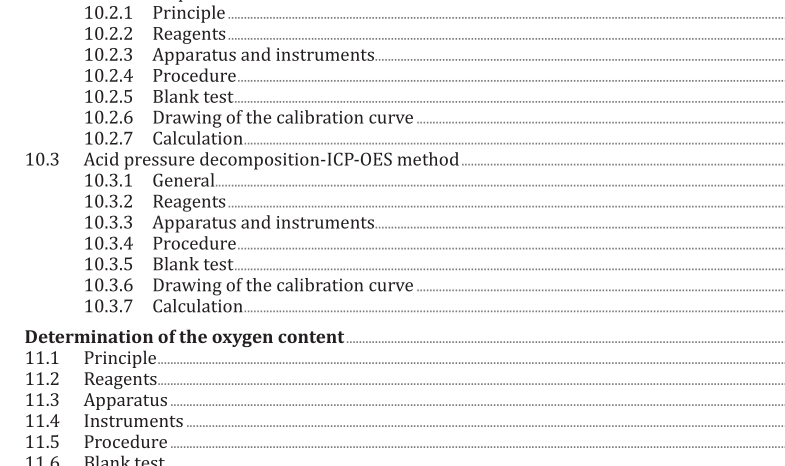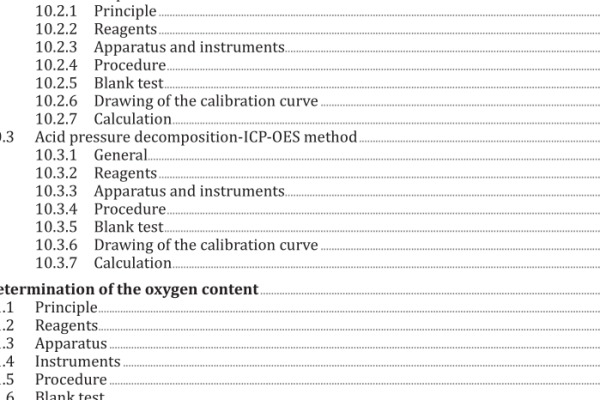ISO 21814:2019 pdf download – Fine ceramics (advanced ceramics, advanced technical ceramics) — Methods for chemical analysis of aluminium nitride powders.
10.2 Acid decomposition-ICP-OES method 10.2.1 Principle To prepare the test solution, the sample is decomposed in sulfuric acid and hydrogen peroxide. Boron, calcium, copper, iron, magnesium, manganese, molybdenum, nickel, potassium, silicon, sodium, titanium, tungsten, vanadium, and zinc are determined by ICP-OES at the selected wavelength. 10.2.2 Reagents Use the reagents described in 7.2.2 as well as the following: 10.2.2.1 Aluminium solution (4,93 g/500 ml), according to 9.2.2.3. 10.2.2.2 Ammonia solution (1+1). 10.2.2.3 Elemental standard solutions. — Boron standard solution (B 1 mg/ml). — Calcium standard solution (Ca 1 mg/ml). — Copper standard solution (Cu 1 mg/ml). — Iron standard solution (Fe 1 mg/ml). — Magnesium standard solution (Mg 1 mg/ml). — Manganese standard solution (Mn 1 mg/ml). — Molybdenum standard solution (Mo 1 mg/ml). — Nickel standard solution (Ni 1 mg/ml). — Potassium standard solution (K 1 mg/ml). — Silicon standard solution (Si 1 mg/ml). — Sodium standard solution (Na 1 mg/ml). — Titanium standard solution (Ti 1 mg/ml). — Tungsten standard solution (W 1 mg/ml). — Vanadium standard solution (V 1 mg/ml). — Zinc standard solution (Zn 1 mg/ml). NOTE The SI traceable commercial standard solutions are available. 10.2.2.4 Mixed standard solution (each element 50 mg/l). Place 5 ml each of the solutions prepared from 10.2.2.3 in a 100 ml plastic volumetric flask. Dilute with sulfuric acid (1+180) to the mark and mix well. Attention shall be paid to ensure that no precipitation occurs during mixing. The solution shall be freshly prepared before use. 10.2.3 Apparatus and instruments Use the apparatus and instruments described in 7.2.3
10.2.4 Procedure 10.2.4.1 Sample decomposition Weigh 0,30 g test sample and transfer it into a 250 ml beaker. Add 15 ml water, 20 ml sulfuric acid, and 10 ml hydrogen peroxide. Covering the beaker with a watch glass and heat at 280 °C until the test sample has been completely dissolved. After cooling, transfer the solution to a 100 ml volumetric flask, dilute with water to the mark and mix well. This solution is designated as the test solution. 10.2.4.2 Measurement Spray a portion of the test solution into the flame of the ICP–OES and measure the emission intensity at an appropriate wavelength (Table 2). Interferences may be encountered. Thus, carefully choose the optimum wavelength that is free from the concomitants.
10.2.5 Blank test Perform the operation described in 10.2.4 without taking a sample to obtain the blank test value. 10.2.6 Drawing of the calibration curve Pour 50 ml aluminium solution (10.2.2.1) and 2,6 ml ammonia solution (1+1) separately into five 100 ml plastic volumetric flasks. Add 0 ml, 1 ml, 2 ml, 3 ml, 4 ml, and 5 ml of the mixed standard solution (10.2.2.4) stepwise and precisely. Dilute each solution with sulfuric acid (1+180) to the mark and mix well. Spray a portion of each solution into the flame of ICP–OES and measure the emission intensity at an appropriate wavelength. 10.2.7 Calculation Determine the concentration of each element in the test solution and in the blank from the calibration curve. Calculate the element content from Formula (9). NOTE The analytical results obtained from a round robin test are listed in Annex A.
ISO 21814:2019 pdf download – Fine ceramics (advanced ceramics, advanced technical ceramics) — Methods for chemical analysis of aluminium nitride powders






